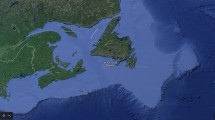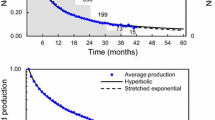Abstract
Louisiana’s Haynesville shale has been actively developed since its discovery, but in recent years there has been rapid retrenchment in the region and a precipitous decline in the number of new wells drilled. Cheap credit, irrational exuberance, and risk taking have played key roles in the investment decisions of operators, but work remains to sustain production and make the play more efficient and successful to attract capital. To better understand the trade-offs in unconventional development, Louisiana’s Haynesville shale is used as a case study to evaluate trends in production profiles, expected recovery volumes, development cost, and operator performance. Average production profiles have improved from 2008 to 2012 reflecting better identification of sweet spots and improved completion designs. In 2008, the expected recovery volume for a Haynesville well was 2.3 Bcf, which by 2011 increased to 5.7 Bcf per well. About two-thirds of the 2,248 producing Haynesville wells circa March 2013 are expected to recover between 2.5 and 10 Bcf over their lifetime, and the total expected recovery volume from the current well inventory is estimated to be 13.9 Tcf. The average cost to develop one Mcf of Louisiana Haynesville shale reserves to the point of production is estimated to be $1.8/Mcf, and more than half of the March 2013 well inventory is expected to have development cost greater than $3/Mcf. This is the first time development cost has been computed for any play in the U.S. based on wellbore cost statistics.























Similar content being viewed by others
Notes
See “Appendix” section for conversion from English to metric units.
Delays between the end of completion and the start of production occur if the operator is waiting on orders, pipeline, permits, testing, etc.
Multiple-well LUWs have more than one well drilled on the unit, presumably because the geologic or economic conditions warrant multiple wells, and so we might expect the average well on a multiple-well LUW to be better than the average well on a single-well LUW, assuming all other conditions the same. If lower quality geology or economics forces multiple development wells, then we would expect lower average performance characteristics.
Better forecast models exist that are aligned with the physics of the reservoir and fluid flow, but the incremental improvement relative to the additional time and effort to implement was not considered adequate.
PUD reserves are known with a high degree of certainty, but capital expenditures have not been spent to “prove up” the reserves and are associated with greater development risk and are less valuable than producing reserves. SEC requirements loosened the traditional one offset allowances in 2008 if “reliable” technologies are applied when booking PUD volumes, but if not developed within 5 years, PUD reserves must be removed from the operator’s reserves disclosures and delisted.
Active wells include producing, idle, and drilling in-progress wells.
References
Billa, R., Mota, J., Schneider, B., & Weissman, M. (2011). Drilling performance improvement in the Haynesville shale. Paper presented at the SPE/IADC Drilling Conference and Exhibition, 1–3 March 2011, Amsterdam, The Netherlands. SPE 139842.
Giles, M.R., Nevin, D., Johnston, B., & Hollanders, M. (2012). Understanding volumes, economics and risk mitigation in unconventional gas projects. Paper presented at the SPE/EAGE European Unconventional Resources Conference and Exhibition, Vienna, Austria, 20–22 March 2012. SPE 151906.
Guo, Q., Ji, L., Rajabov, V., Friedheim, J., & Wu, R. (2012). Marcellus and Haynesville drilling data: analysis and lessons learned. Paper presented at the SPE Asia Pacific Oil and Gas Conference and Exhibition, 22–24 October 2012, Perth, Australia. SPE 158894.
Hammes, U., & Frébourg, G. (2012). Haynesville and Bossier Mudrocks: A facies and sequence stratigraphic investigation, East Texas and Louisiana, USA. Marine and Petroleum Geology, 31, 8–26.
Hammes, U., Hamlin, H. S., & Ewing, T. E. (2011). Geologic analysis of the upper Jurassic Haynesville shale in East Texas and West Louisiana. AAPG Bulletin, 95(10), 1643–1666.
Kaiser, M. J. (2012). Economic analysis of Haynesville shale gas wells. Journal of Petroleum Science and Engineering, 82(83), 75–89.
Kaiser, M. J., & Yu, Y. (2011). Haynesville shale gas well performance and development potential. Natural Resources Research, 20(4), 217–229.
Kaiser, M. J. & Yu. Y. (2014). Drilling and completion cost in the Haynesville Louisiana shale play, 2007–2012. Natural Resources Research. doi:10.1007/s11053-014-9229-9.
Kauerauf, A. I., Mavridou, E., & de Lind van Wijngaarden, M. C. (2010). An uncertainty evaluation for the Haynesville shale gas play. AAPG Geosciences Technology Workshop on Basin and Petroleum System Modeling in the Middle East: Applications and Case Studies, Dubai, UAE, October 11–13, 2010.
Mavridou, E., de Lind van Wijngaarden, M. C., & Kauerauf, A. J. (2010). Petroleum systems modeling of the Haynesville shale gas play. Paper presented at the Second Workshop on Exploration Unconventional Resources, Cairo, Egypt, December 4–7, 2010.
Modeland, N., Buller, D., &. Chong, K. (2011). Statistical analysis of the effect of completion methodology on production in the Haynesville shale. Paper presented at the North American Unconventional Gas Conference and Exhibition, 14–16 June 2011, The Woodlands, TX, USA. SPE 144120.
Neber, A., Cox, S., Levy, T., Schenk, O., Tessen, N., Wygrala, B., & Bryant, I. (2012). Systematic evaluation of unconventional resource plays using a new play-based exploration methodology. Paper presented at the SPE Asia Pacific Oil and Gas Conference and Exhibilition, Perth, Australia, October 22–24, 2012. SPE 158571.
NETL U.S. Department of Energy (2009). Modern shale gas development in the United States: A primer. Office of Fossil Energy, National Energy Technology Laboratory. April: 116.
Okouma, V., Guillot, F., Sarfare, M., San, V., Ilk, D., &. Blasingame, T. (2011). Estimated ultimate recovery (EUR) as a function of production practices in the Haynesville shale. Paper presented at the SPE Annual Technical Conference and Exhibition, 30 October–2 November 2011, Denver, CO, USA. SPE 147623.
Pope, C. D., Palisch, T. T., Lolon, E. P., Dzubin, B. A., &. Chapman, M. A. (2010). Improving stimulation effectiveness: Field results in the Haynesville shale. Paper presented at the SPE Annual Technical Conference and Exhibition, 19–22 September 2010, Florence, Italy. SPE 134165.
Strickland, R., Purvis, D. & Blasingame, T. (2011). Practical aspects of reserves determinations for shale gas. Paper presented at the North American Unconventional Gas Conference and Exhibition, 14–16 June 2011, The Woodlands, TX, USA. SPE 144357.
Vincent, M. C. (2002). Proving it—A review of 80 published field studies demonstrating the importance of increased fracture conductivity. Paper presented at the SPE Annual Technology Conference and Exhibition, San Antonio, TX, Sep 29–Oct 2, 2002. SPE 77675.
Wang, F. P., & Hammes, U. (2010). Effects of petrophysical factors on Haynesville fluid flow and production. World Oil, June 2010, p. D-82.D79.
Xie, X., Glashan, J. M., Holzhauser, S., &. Knott, G. (2012). Completion influence on Haynesville shale gas well performance. Paper presented at the SPE Hydrocarbon Economics and Evaluation Symposium, 24–25 September 2012, Calgary, AB, Canada. SPE 159823.
Author information
Authors and Affiliations
Corresponding author
Appendix
Appendix
Conversion Factors
1 ft = 0.31 m
1 mi = 1.61 km
1 sq mi = 2.59 sq km
100 ac = 40 ha
1 in = 2.54 cm
1 Tcf = 29.8 MMcm
Rights and permissions
About this article
Cite this article
Kaiser, M.J. Haynesville Louisiana Drilling and Production Update 2012. Nat Resour Res 24, 33–51 (2015). https://doi.org/10.1007/s11053-014-9231-2
Received:
Accepted:
Published:
Issue Date:
DOI: https://doi.org/10.1007/s11053-014-9231-2




